(单词翻译:单击)
英文原文
为什么冬天会打雷呢?大家知道,雷电是雷雨云中的放电现象。这种云的底部离地面约1公里高,一般云顶带正电荷,云底带负电荷,相应的地面也产生与云底电荷相反的感应电荷。由于对流作用,云上下运动,云内的冰晶相互摩擦使电荷逐步增多,云的内部、云与云、云与地面之间的同电荷区形成了很强的电场,电场达到一定强度就要相互中和而发生放电,在光的通路上产生高温,使四周空气剧烈受热,突然膨胀,发生巨大的响声,这就是雷鸣。
【英文原文】
It's a common enough sound in summer, after the wind finally picks up on a hot and humid afternoon, as the rain starts spattering down in big, fat drops--you're in for a full-blown thunderstorm.
It's much less common in winter, even during a snow storm. Why is thunder so much more likely in summer than in winter? We'll learn about thunder snow, on today's Moment of Science.
In a summer thunder storm, the atmosphere is stacked up like a two-layer cake. The lower layer is full of warm, moist air; the upper layer is icy cold and dry. Because hot air rises, there are soon tremendous updrafts, carrying the warm moisture of the lower layer up into the cold, dry layer. The turbulence of these updrafts creates static electricity as the air masses rub against each other. Thunder and lightning occur when the static electricity discharges in a giant bolt of electricity.
In the winter, the layer of air near the ground is likely to be a lot colder and drier than it is in the summer. It's much harder to get the sharp divisions in the atmosphere that lead to turbulence, static electricity, and thunder. It can happen though, especially near the coast. A thunderstorm can form over the relatively warm and moist air over the ocean, then move into the icy atmosphere over the land. When this happens, you'll get a sharp atmospheric division in a snow storm, and you'll get a thunder snow.
参考译文
【参考译文】
打雷在夏天的时候是再普通不过的一件事,在一个刮风的,湿热的下午,大雨倾盆而至,这就是一个暴风雨。
但是在冬天却很少见,即使是暴风雪的时候,也很少会打雷。为什么夏天更容易打雷?今天我们就来看看下雪打雷的事。
夏天的雷雨天气时,大气就如同堆积在一起的两层蛋糕。最下面一层充满了温暖潮湿的空气,上面一层则是冰冷干燥的空气。当热气上升的时候,会形成很大的上升气流,将下面一层的湿热的空气带入到上面干冷的空气中。在这个过程中,大气之间相互摩擦而产生很大的摩擦力。当静电达到一定的程度的时候就会产生闪电和雷。
冬天的时候,接近地面的空气比夏天要干冷很多,很难产生像夏天那样的空气对流,因此很难形成气流,静电和打雷。但是在海岸附近还是有可能会产生雷电。一场雷电交加的暴风雨有可能在海洋上空较为湿热的空气中产生,这种情况产生后,也有可能形成明显的两层大气层,继而产生下雪打雷的现象。
相关报道
【相关报道】
1.you're in for a full-blown thunderstorm
这就是一场全面的雷电交加的暴风雨。
full-blown adj. 盛开的,成熟的,全面的
如:The fighting may develop into a full-blown war.
战斗可能会发展成全面性的战争。
2.In a summer thunderstorm, the atmosphere is stacked up like a two-layer cake.
夏天的雷雨天气时,大气就如同堆积在一起的两层蛋糕
stack up 堆积很高,形成拥挤的人群
如:How much do all these figures stack up to?
这些数字的总和是多少?
How does our product stack up against those of yours?
我们的产品与你们的相比怎么样?
3.When this happens, you'll get a sharp atmospheric division in a snow storm, and you'll get a thunder snow.
这种情况产生后,也有可能形成明显的两层大气层,继而产生下雪打雷的现象。
atmospheric adj. 大气的,大气层的,制造气氛的
如:What's the atmospheric pressure today?
今天的气压怎么样?



